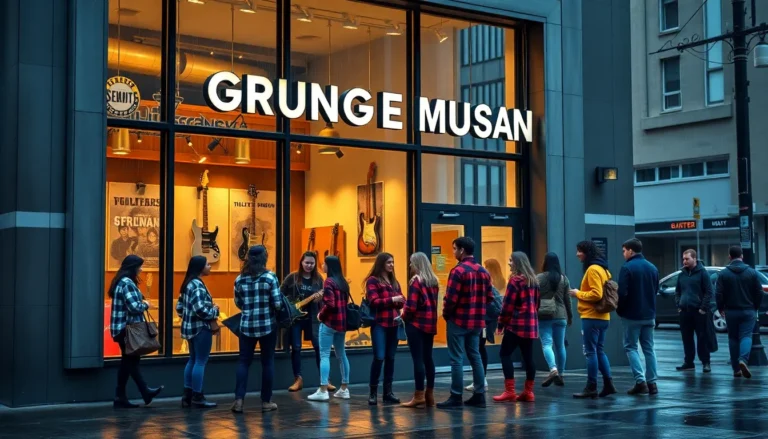TV cliffhangers are the ultimate tease, leaving viewers hanging on the edge of their seats—sometimes literally! Just when the plot thickens and the drama peaks, the screen fades to black, and audiences are left shouting at their remotes. They’re not just a storytelling device; they’re a love-hate relationship that keeps fans coming back for more, even if it means enduring a few sleepless nights pondering what happens next.
Table of Contents
ToggleThe Art of TV Cliffhangers
TV cliffhangers create tension, drawing viewers back for more. Producers craft these moments meticulously, ensuring that each one heightens anticipation. Characters face perilous situations, leaving audiences questioning their fates. For instance, a beloved character’s life hangs in the balance; this uncertainty compels fans to tune in for resolution.
Strategic placement of cliffhangers often occurs at the end of episodes. Viewers experience heart-pounding suspense, grappling with unresolved conflicts. Writers leverage character development, allowing cliffhangers to resonate emotionally. Strong connections between characters and audiences elevate the impact of these suspenseful moments.
Different genres, including drama, thriller, or fantasy, utilize cliffhangers uniquely. In a drama, revealing a shocking betrayal sparks outrage and excitement. For thrillers, sudden twists introduce danger that propels the narrative forward. Fantasy series often create cliffhangers around mythical elements, igniting curiosity about the story’s direction.
Successful shows utilize pacing to maximize suspense. Techniques such as building tension gradually, then delivering a shocking revelation, maintain viewer engagement. Use of visual and auditory cues augments this effect, creating a compelling experience. Fans embrace the thrill of speculation, exchanging theories and predictions on social media.
Balancing satisfaction with frustration remains crucial for writers. Overusing cliffhangers risks alienating audiences. Resolved storylines alongside well-placed suspense ensure viewers remain invested. Ultimately, the art of cliffhangers lies in their ability to evoke strong emotional responses and foster dedicated fanbases.
Memorable TV Cliffhangers in History

TV cliffhangers have delivered some of the most memorable moments in entertainment history. Iconic scenes provoke anticipation and debate among fans, propelling series into cultural conversations.
Iconic Shows and Their Cliffhangers
“Who Shot J.R.?” from Dallas shocked audiences in 1980, creating an unforgettable moment that left viewers on edge. The Simpsons captivated audiences with “Who Shot Mr. Burns?” as it united fans in speculation. Similarly, Lost featured a pivotal moment with the hatch, altering viewers’ understanding of the island. These shows used cliffhangers to maintain suspense and ensure loyal followings. Each cliffhanger expertly positioned characters in peril, compelling audiences to return for resolutions.
Audience Reactions to Cliffhangers
Reactions to cliffhangers illustrate the phenomenon’s emotional impact. Fans often express frustration paired with excitement, eager to uncover character fates. Social media buzzes with theories as viewers dissect every detail, amplifying anticipation for upcoming episodes. Audience engagement skyrockets, reflecting the effectiveness of these strategic narrative techniques. Viewers connect emotionally to characters, leading to lengthy discussions and heightened anticipation. This blend of excitement and anxiety demonstrates the unique power cliffhangers hold over storytelling.
The Psychology Behind Cliffhangers
Cliffhangers tap into powerful psychological mechanisms that engage viewers deeply. These storytelling techniques create intense suspense and anticipation, compelling audiences to return for the next episode.
Building Suspense and Anticipation
Producers construct suspense through strategic pacing and carefully timed revelations. They position critical moments toward the end of episodes, which maximizes viewer engagement. By causing characters to face dire situations, producers leave audiences in a state of uncertainty. Techniques such as foreshadowing and misdirection enhance this suspense further. Elements like dramatic music and visual cues intensify the emotional stakes. Each cliffhanger invites speculation and debate among fans, increasing investment in the storyline. Consequently, this anticipation fosters a stronger connection to the narrative and characters.
Emotional Impact on Viewers
Cliffhangers evoke a range of emotional responses from viewers. Audiences often experience heightened levels of anxiety and excitement when left with unresolved conflicts. Such moments create an adrenaline rush, making the viewing experience memorable. Viewers become emotionally invested in characters, often forming attachments that deepen appreciation for the story. Fans engage in discussions and theories on social media, demonstrating the communal aspect of their experience. Ultimately, the suspense and uncertainty generate a unique emotional landscape, reinforcing loyalty to shows that masterfully employ cliffhangers.
Analyzing Recent TV Cliffhangers
Recent TV cliffhangers reveal evolving narrative techniques that captivate audiences. Producers embrace innovative storytelling, intertwining plot threads and complex character arcs to keep viewers guessing. Series often employ unexpected twists, reshaping familiar tropes while enhancing suspense. The importance of pacing becomes clear as creators build tension consistently throughout episodes. Cliffhangers frequently reframe viewer expectations, leading to more profound emotional connections with characters. As a result, audiences find themselves invested in multiple storylines.
Trends in Modern Storytelling
Modern storytelling trends highlight an increase in serialized narratives. Shows now strive for cohesion across episodes, compelling viewers to stay engaged. Character-centric plots thrive, allowing audiences to explore motivations deeply. An embrace of diverse genres allows cliffhangers to emerge across a wider range of programming. Social issues often intertwine in narratives, creating relatable stakes for viewers. Each trend contributes to a more immersive and stimulating viewing experience.
Audience Engagement and Social Media
Audience engagement dramatically shifts in the age of social media. Viewers actively participate in discussions surrounding cliffhangers, generating theories and speculations online. Platforms like Twitter and Reddit foster interaction between fans and creators, amplifying excitement. Engaging with audiences in real-time allows producers to refine their storytelling approach. Community-driven conversations create a sense of belonging, enhancing loyalty to shows. This dynamic encourages the growth of passionate fanbases invested in the characters’ fates.
TV cliffhangers are more than just storytelling devices; they’re a powerful way to engage audiences and create lasting emotional connections. By leaving viewers on the edge of their seats, these suspenseful moments foster intense discussions and theories that thrive in the age of social media.
As producers continue to innovate and explore new narrative techniques, the impact of cliffhangers will only grow. They not only enhance the viewing experience but also cultivate dedicated fanbases eager for the next twist. In the ever-evolving landscape of television, cliffhangers remain a vital tool in keeping audiences invested and excited for what’s to come.








